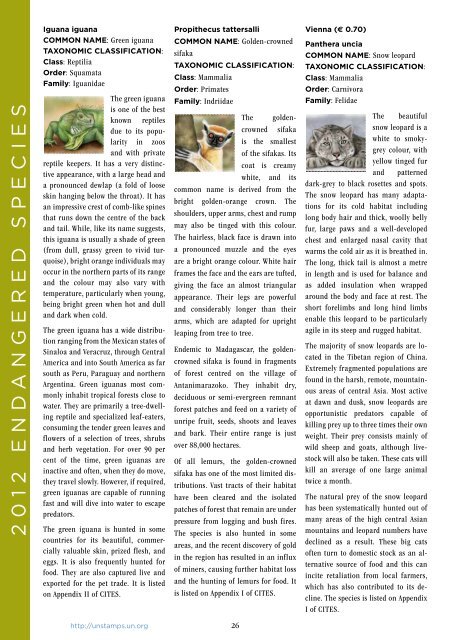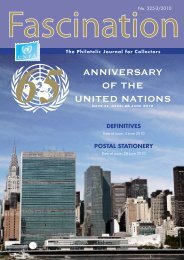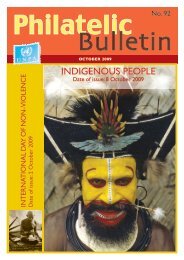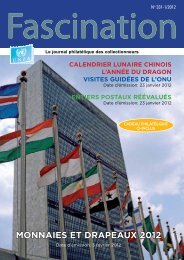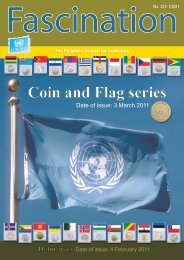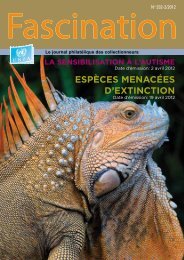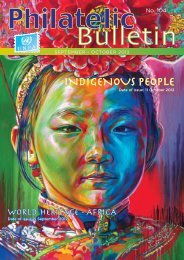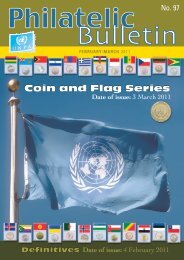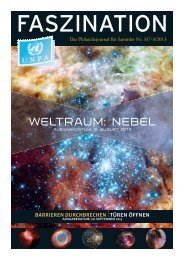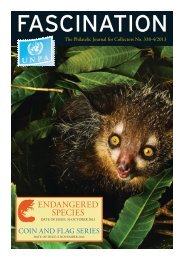endangered species - United Nations Postal Administration - ONU
endangered species - United Nations Postal Administration - ONU
endangered species - United Nations Postal Administration - ONU
You also want an ePaper? Increase the reach of your titles
YUMPU automatically turns print PDFs into web optimized ePapers that Google loves.
2012 Endangered <strong>species</strong><br />
Iguana iguana<br />
COMMON NAME: Green iguana<br />
TAXONOMIC CLASSIFICATION:<br />
Class: Reptilia<br />
Order: Squamata<br />
Family: Iguanidae<br />
The green iguana<br />
is one of the best<br />
known reptiles<br />
due to its popularity<br />
in zoos<br />
and with private<br />
reptile keepers. It has a very distinctive<br />
appearance, with a large head and<br />
a pronounced dewlap (a fold of loose<br />
skin hanging below the throat). It has<br />
an impressive crest of comb-like spines<br />
that runs down the centre of the back<br />
and tail. While, like its name suggests,<br />
this iguana is usually a shade of green<br />
(from dull, grassy green to vivid turquoise),<br />
bright orange individuals may<br />
occur in the northern parts of its range<br />
and the colour may also vary with<br />
temperature, particularly when young,<br />
being bright green when hot and dull<br />
and dark when cold.<br />
The green iguana has a wide distribution<br />
ranging from the Mexican states of<br />
Sinaloa and Veracruz, through Central<br />
America and into South America as far<br />
south as Peru, Paraguay and northern<br />
Argentina. Green iguanas most commonly<br />
inhabit tropical forests close to<br />
water. They are primarily a tree-dwelling<br />
reptile and specialized leaf-eaters,<br />
consuming the tender green leaves and<br />
flowers of a selection of trees, shrubs<br />
and herb vegetation. For over 90 per<br />
cent of the time, green iguanas are<br />
inactive and often, when they do move,<br />
they travel slowly. However, if required,<br />
green iguanas are capable of running<br />
fast and will dive into water to escape<br />
predators.<br />
The green iguana is hunted in some<br />
countries for its beautiful, commercially<br />
valuable skin, prized flesh, and<br />
eggs. It is also frequently hunted for<br />
food. They are also captured live and<br />
exported for the pet trade. It is listed<br />
on Appendix II of CITES.<br />
Propithecus tattersalli<br />
COMMON NAME: Golden-crowned<br />
sifaka<br />
TAXONOMIC CLASSIFICATION:<br />
Class: Mammalia<br />
Order: Primates<br />
Family: Indriidae<br />
The goldencrowned<br />
sifaka<br />
is the smallest<br />
of the sifakas. Its<br />
coat is creamy<br />
white, and its<br />
common name is derived from the<br />
bright golden-orange crown. The<br />
shoulders, upper arms, chest and rump<br />
may also be tinged with this colour.<br />
The hairless, black face is drawn into<br />
a pronounced muzzle and the eyes<br />
are a bright orange colour. White hair<br />
frames the face and the ears are tufted,<br />
giving the face an almost triangular<br />
appearance. Their legs are powerful<br />
and considerably longer than their<br />
arms, which are adapted for upright<br />
leaping from tree to tree.<br />
Endemic to Madagascar, the goldencrowned<br />
sifaka is found in fragments<br />
of forest centred on the village of<br />
Antanimarazoko. They inhabit dry,<br />
deciduous or semi-evergreen remnant<br />
forest patches and feed on a variety of<br />
unripe fruit, seeds, shoots and leaves<br />
and bark. Their entire range is just<br />
over 88,000 hectares.<br />
Of all lemurs, the golden-crowned<br />
sifaka has one of the most limited distributions.<br />
Vast tracts of their habitat<br />
have been cleared and the isolated<br />
patches of forest that remain are under<br />
pressure from logging and bush fires.<br />
The <strong>species</strong> is also hunted in some<br />
areas, and the recent discovery of gold<br />
in the region has resulted in an influx<br />
of miners, causing further habitat loss<br />
and the hunting of lemurs for food. It<br />
is listed on Appendix I of CITES.<br />
Vienna (€ 0.70)<br />
Panthera uncia<br />
COMMON NAME: Snow leopard<br />
TAXONOMIC CLASSIFICATION:<br />
Class: Mammalia<br />
Order: Carnivora<br />
Family: Felidae<br />
The beautiful<br />
snow leopard is a<br />
white to smokygrey<br />
colour, with<br />
yellow tinged fur<br />
and patterned<br />
dark-grey to black rosettes and spots.<br />
The snow leopard has many adaptations<br />
for its cold habitat including<br />
long body hair and thick, woolly belly<br />
fur, large paws and a well-developed<br />
chest and enlarged nasal cavity that<br />
warms the cold air as it is breathed in.<br />
The long, thick tail is almost a metre<br />
in length and is used for balance and<br />
as added insulation when wrapped<br />
around the body and face at rest. The<br />
short forelimbs and long hind limbs<br />
enable this leopard to be particularly<br />
agile in its steep and rugged habitat.<br />
The majority of snow leopards are located<br />
in the Tibetan region of China.<br />
Extremely fragmented populations are<br />
found in the harsh, remote, mountainous<br />
areas of central Asia. Most active<br />
at dawn and dusk, snow leopards are<br />
opportunistic predators capable of<br />
killing prey up to three times their own<br />
weight. Their prey consists mainly of<br />
wild sheep and goats, although livestock<br />
will also be taken. These cats will<br />
kill an average of one large animal<br />
twice a month.<br />
The natural prey of the snow leopard<br />
has been systematically hunted out of<br />
many areas of the high central Asian<br />
mountains and leopard numbers have<br />
declined as a result. These big cats<br />
often turn to domestic stock as an alternative<br />
source of food and this can<br />
incite retaliation from local farmers,<br />
which has also contributed to its decline.<br />
The <strong>species</strong> is listed on Appendix<br />
I of CITES.<br />
http://unstamps.un.org<br />
26


